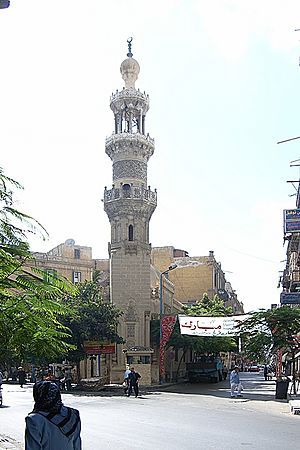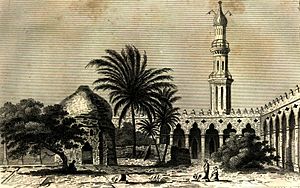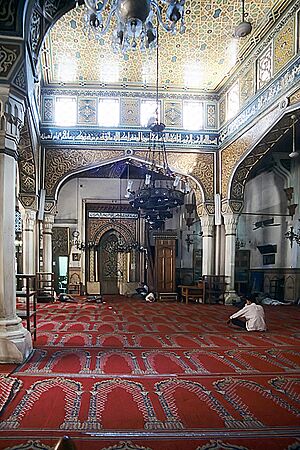Attarine Mosque facts for kids
Quick facts for kids Attarine Mosque |
|
|---|---|
|
مسجد العطارين
|
|

View of the Attarine Mosque from the similarly named street, giving a good view of the minaret
|
|
| Religion | |
| Affiliation | Sunni Islam |
| Location | |
| Location | Alexandria, Egypt |
| Architecture | |
| Architectural type | mosque |
| Architectural style | Ottoman, Mamluk |
| Date established | 370 (as church), 641 (as mosque) |
| Completed | 370 (church), 1912 (mosque) |
| Specifications | |
| Dome(s) | 1 |
| Minaret(s) | 1 |
| Shrine(s) | 1 |
| Former church, then mosque, contained the sarcophagus of Nectanebo II | |
The Attarine Mosque (Arabic: مسجد العطارين) is a very old and important mosque. It is also called the Al-Juyushi Mosque (Arabic: الجامع الجيوشى). You can find it in Alexandria, Egypt.
This mosque was built where an old church used to stand. That church was first for Athanasius of Alexandria and later for Saint Sabbas. The mosque you see today was mostly built in the early 1900s. Many of its first parts are gone. But there is a stone with writing that remembers Badr al-Jamali. He helped fix up the mosque a long time ago.
Contents
History of the Attarine Mosque
From Temple to Church
A very long time ago, in 370 AD, a church was built in Alexandria. It was called the Church of Bendideion. This church was built on the site of an even older temple. This temple was for a goddess named Bendis. The church was located on the northern side of what was then called the Canopic street.
The Monastery and Its Rebuilding
Later, in the 7th century, monks started to build small living spaces around an old church. This was the beginning of a monastery. Sadly, an earthquake destroyed this first monastery. But a rich person rebuilt it. They dedicated the new building to Saint Sabbas the Sanctified.
Becoming a Mosque
On November 8, 641 AD, the city of Alexandria came under Muslim rule. This happened after a long fight led by Amr ibn al-As. The Byzantine Empire gave the city to the Muslims. After this, the church was changed into a mosque.
Over time, the mosque was not used and fell apart. During the Fatimid period, a leader named Badr al-Jamali paid to have the mosque fully fixed. He used money from taxes collected in Alexandria.
Later Restorations
During the time of the Mamluk Sultan Al-Nasir Muhammad, the Attarine Mosque was a main mosque. People gathered there for Friday prayers. But after his death, the mosque was again not cared for.
Then, Khedive Abbas II of Egypt became the ruler. He ordered his workers to plan a new restoration. The mosque was completely rebuilt from the ground up. The building you see today is from that rebuilding project.
Architecture of the Mosque
Layout and Features
The Attarine Mosque has a rectangular shape. It has two levels. The ground floor is for men to pray. In the middle of the open area, called the courtyard, there are four stone pillars. These pillars are connected to two columns made of marble.
The mosque has a special opening in the roof, like a skylight. It has four plaster window openings on each side. Below the roof in the middle part, you can see beautiful writing. These are verses from the Surah al-Fatihah, which is a chapter from the Quran.
Shops and Minaret
On the southern side of the mosque, there are several shops. The money earned from these shops helps pay for the mosque's repairs and upkeep. The mosque has one tall tower, called a minaret. It is made of brick.
The Mausoleum
On the eastern side of the mosque, there is a small tomb, or mausoleum. You can get to it from the eastern entrance. This mausoleum is for a local holy person named Muhammad ibn Sulayman. He was the grandson of a famous military leader, Khalid ibn al-Walid. This mausoleum was built when Khedive Abbas II was in charge.
Amazing Archeological Finds
The Sarcophagus of Nectanebo II
During the time when Napoleon ruled Egypt, a large stone coffin was found. This coffin, called a sarcophagus, was discovered in the mosque's courtyard. Later, people found out it belonged to Nectanebo II. He was the last native Egyptian Pharaoh, or king.
Nectanebo II was not actually buried inside this sarcophagus. He had already left Egypt before another group of people, the Persians, took over. When the Muslims ruled, this sarcophagus was used as a basin for water. People used it to wash themselves before prayers. Twelve holes were drilled into it to let the water drain out.
Today, this sarcophagus is in the British Museum in London. It has been there since 1802.
See also
- Lists of mosques
- List of mosques in Africa
- List of mosques in Egypt




